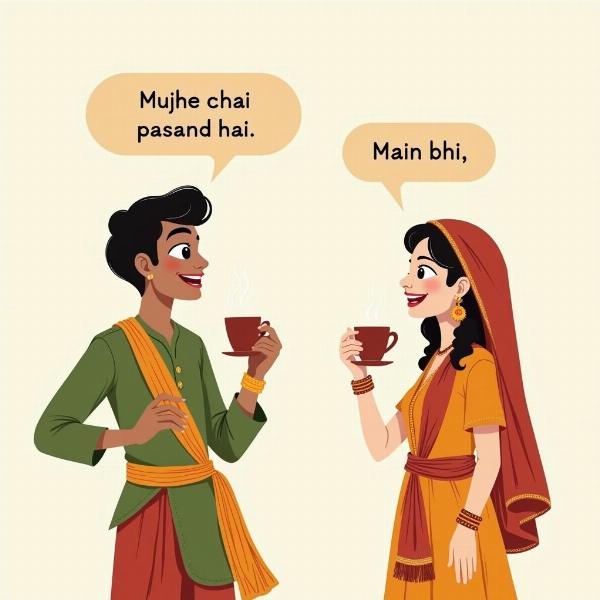Understanding the nuances of translating phrases like “so do I” into Hindi can be tricky. While a direct word-for-word translation might seem simple, capturing the true essence of the phrase requires a deeper understanding of both English and Hindi grammar and cultural context. “So do I” expresses agreement or shared experience, and finding the right Hindi equivalent depends on the specific situation. This article explores various ways to express “so do I” in Hindi, offering a range of options from formal to informal, and covering different tenses and contexts.
Different Ways to Say “So Do I” in Hindi
Several Hindi phrases convey the meaning of “so do I,” each with its own subtle implications. Choosing the appropriate phrase depends heavily on the preceding statement and the social context.
- Main bhi (मैं भी): This is the most common and versatile translation, literally meaning “me too.” It’s suitable for most situations, both formal and informal.
- Mujhe bhi (मुझे भी): This translates to “me too” but specifically refers to experiencing something, rather than performing an action. Use this when agreeing with a statement about a feeling or sensation.
- Aisa hi mere saath bhi hai (ऐसा ही मेरे साथ भी है): A more formal and emphatic option, meaning “the same is with me also.” This is suitable for expressing agreement in a more serious or official setting.
- Bilkul (बिल्कुल): While not a direct translation, “bilkul” means “absolutely” or “exactly,” and can be used as a standalone response to express strong agreement.
- Haan, main bhi (हाँ, मैं भी): Adding “haan” (yes) before “main bhi” reinforces the agreement, particularly in conversational Hindi.
 Hindi Conversation Example
Hindi Conversation Example
Understanding the Context
The best translation of “so do I” depends on the context of the conversation. Let’s examine a few examples:
- Statement: “I like spicy food.” Hindi: “Mujhe mirch wala khana pasand hai (मुझे मिर्च वाला खाना पसंद है).” Response: “Main bhi (मैं भी)” – This is a simple agreement with a preference.
- Statement: “I feel tired.” Hindi: “Main thak gaya hoon (मैं थक गया हूँ).” (masculine) / “Main thak gayi hoon (मैं थक गई हूँ).” (feminine) Response: “Mujhe bhi (मुझे भी)” or “Main bhi thak gaya/gayi hoon (मैं भी थक गया/गई हूँ).” – Here, “mujhe bhi” emphasizes the shared feeling of tiredness.
- Statement: “I went to the market yesterday.” Hindi: “Main kal bazaar gaya tha (मैं कल बाज़ार गया था).” (masculine) / “Main kal bazaar gayi thi (मैं कल बाज़ार गई थी).” (feminine) Response: “Main bhi (मैं भी)” or “Main bhi kal bazaar gaya/gayi tha/thi (मैं भी कल बाज़ार गया/गई था/थी).” – Using the past tense in the response shows agreement with the specific action.
Common Mistakes to Avoid
- Direct Translation: Avoid translating “so do I” literally. Hindi grammar and sentence structure differ significantly from English, and a direct translation often sounds unnatural.
- Ignoring Tense: Ensure the tense of your response matches the original statement. Using the wrong tense can change the meaning.
- Overusing “Bhi”: While “bhi” is essential, avoid adding it unnecessarily to other words in the sentence.
Conclusion
Mastering the art of saying “so do I” in Hindi involves understanding the nuances of the language and the context of the conversation. By using the right phrases and paying attention to tense and context, you can communicate effectively and avoid common mistakes. Remember that practice makes perfect, so don’t hesitate to try out these different expressions in your conversations.
FAQs
- What is the most common way to say “so do I” in Hindi? The most common way is “main bhi (मैं भी).”
- When should I use “mujhe bhi” instead of “main bhi”? Use “mujhe bhi” when agreeing with a statement about a feeling or experience.
- Is there a formal way to say “so do I” in Hindi? Yes, “aisa hi mere saath bhi hai (ऐसा ही मेरे साथ भी है)” is a more formal option.
- Can I just say “bilkul” to mean “so do I”? While not a direct translation, “bilkul” can express strong agreement and serve a similar function.
- How do I use “so do I” in the past tense in Hindi? Match the tense of the original statement, e.g., “main bhi kal bazaar gaya/gayi tha/thi (मैं भी कल बाज़ार गया/गई था/थी).”
Meaning-Hindi.in is your premier resource for professional Hindi translation services. We specialize in various translation domains, including business, legal, technical, website localization, educational, and specialized content. We offer accurate, culturally sensitive translations tailored to your specific needs. Contact us today for a free quote! Email: [email protected], Phone: +91 11-4502-7584. Meaning-Hindi.in provides high-quality and reliable Hindi translation services to bridge the communication gap between languages and cultures.